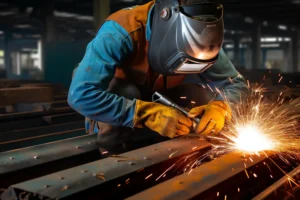Vertical welds play a pivotal role in various industries, including construction, manufacturing, and shipbuilding. Ensuring the integrity of these welds is essential for the structural stability and safety of the final product. However, several factors can influence the quality and strength of vertical welds. In this article, we will delve into these factors and explore how they affect the integrity of vertical welds.
First and foremost, the welding technique employed greatly impacts the integrity of vertical welds. Proper welding techniques, such as using the correct heat settings, electrode angles, and travel speeds, are crucial for achieving sound welds. Welders must pay close attention to maintaining a consistent arc length and electrode position throughout the welding process to prevent defects such as undercutting or incomplete fusion.
The choice of welding process also plays a significant role in determining the integrity of vertical welds. Processes like shielded metal arc welding (SMAW), gas metal arc welding (GMAW), and flux-cored arc welding (FCAW) are commonly used for vertical welding applications. Each process has its advantages and limitations, and selecting the most suitable process depends on factors such as material thickness, joint design, and accessibility.
Material selection and preparation are key factors that can affect the quality of vertical welds. Different materials have varying metallurgical properties and susceptibility to welding defects. Proper cleaning and preheating of the base metals help eliminate contaminants and reduce the risk of porosity and cracking in the welds. Additionally, selecting the appropriate filler metal compatible with the base metal composition is essential for achieving strong and durable vertical welds.
Joint design and fit-up are critical considerations in vertical welding applications. Proper joint preparation, including beveling and edge alignment, ensures adequate penetration and fusion of the weld metal. Improper fit-up can lead to gaps or misalignment, resulting in weak and unreliable welds. Welding in the vertical position presents unique challenges compared to horizontal or overhead welding, requiring careful attention to joint geometry and accessibility.
External factors such as environmental conditions and welding location also influence the integrity of vertical welds. Ambient temperature, humidity levels, and wind speed can affect the welding process and the behavior of molten metal. Welding in confined spaces or at elevated heights adds complexity to the process and requires additional safety precautions to prevent accidents and ensure quality welds.
Proper inspection and testing procedures are essential for verifying the integrity of vertical welds. Visual inspection, radiographic testing, ultrasonic testing, and magnetic particle inspection are commonly used methods for detecting weld defects and assessing weld quality. Regular inspection and maintenance help identify potential issues early on and prevent costly repairs or failures in the future.
In conclusion, the integrity of vertical welds is influenced by a combination of factors, including welding technique, welding process, material properties, joint design, environmental conditions, and inspection procedures. By understanding these factors and implementing best practices, welders can consistently produce high-quality vertical welds that meet industry standards and ensure the structural integrity and safety of the final product.

